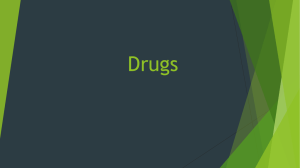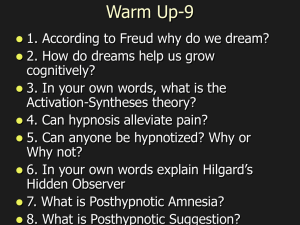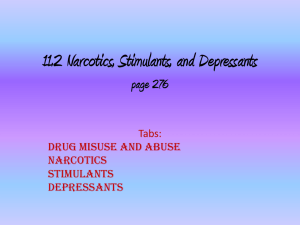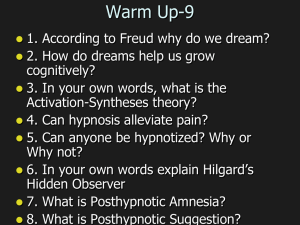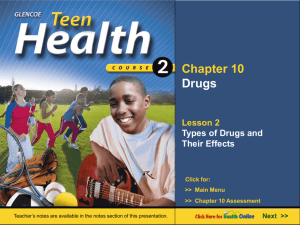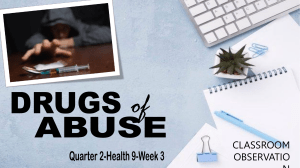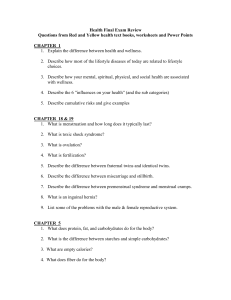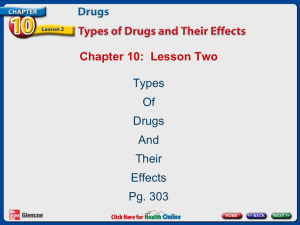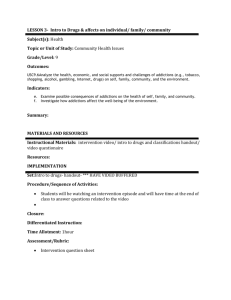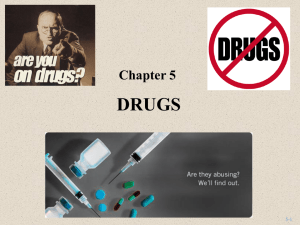Tox_drugs - McEachern High School
advertisement
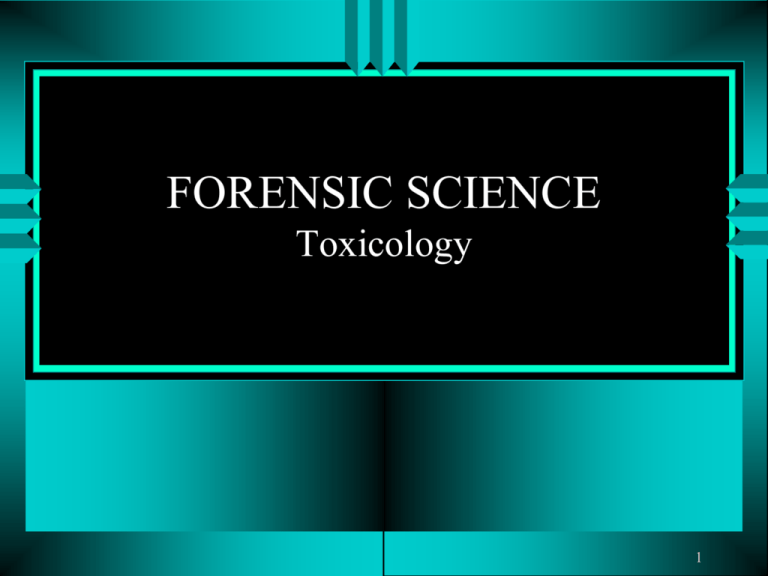
FORENSIC SCIENCE Toxicology 1 Forensic File #2 What does a forensic toxicologist help determine (2 things) ?? 2 Forensic File #2 What does a forensic toxicologist help determine? The cause and effect relationships between exposure to a drug or substance The toxic or lethal effects from exposure 3 Today’s Assignments Due today- Intro to Toxicology webquest Over the next two days: Get both sets of notes from MHS website Labs: Spot test, Urine analysis, Drugs and Money Review: Spectroscopy analysis 4 What is a drug? A natural or synthetic substance that is used to produce physiological effects in humans or other higher order animals 5 What is a controlled substance? All drugs covered by law that are somehow restricted. There are 5 categories of controlled drugs: • Hallucinogens • Stimulants • Narcotics (analgesics) • Depressants • Steroids 6 Hallucinogens What are they? Substances that induces change in mood, attitude, thoughts or perceptions Examples: most popular is marijuana, others include PCP & LSD, Psilocybin (“magic mushrooms”), Ecstasy, ketamine The effect and intensity of response to these drugs varies from person to person 7 Hallucinogens Often derived from plants, hallucinogens affect the user’s perceptions, thinking, selfawareness and emotions Effects of an overdose can include: increased heart rate, increased blood pressure, panic attack, anxiety, psychosis 8 The Hallucinogens most widely used illicit drug in the U.S. is marijuana which is a preparation of the plant Cannabis. It consists of crushed leaves mixed with flowers, stem and seeds. The plant secretes a sticky resin known as hashish. The active ingredient is tetrahydrocannabinol, which is known as THC. 9 Hallucinogens The THC content varies in differnet parts of the plant. The stem, root and seeds have low THC content. Pakistani and Afghan resin comes in hard, brittle blocks and have approximately 3.5% THC Cannabis oil concentrated liquid resin form which looks like motor oil has 20-65% THC content 10 Halllucinogens: LSD: causes visual & auditory hallucinations, can cause psychosis, flashbacks, impaired memory and possible teratogen (causes birth defects) PCP (phencyclidine): insensitivity to pain, rage, memory loss & paranoia Ketamine (special K): animal tranquilizer can cause delirium, amnesia, depression & long-term memory problems 11 Narcotics Analgesic or pain-killing substance that depresses vital body functions such as blood pressure, pulse rate and breathing rate. The regular administration of narcotics will produce physical dependence Affects the central nervous system Narcotics reduce pain and can be very habit forming 12 Narcotics (analgesics) Examples: morphine & derivative heroin, methadone, codiene, oxycontin Otc: mild analgesics- aspirin, tylenol, motrin Overdoses can cause death Synthetic narcotics: methadone (heroin substitute used in rehab), oxycodon (Percocet), fentanyl is 100 times stronger than morphine (spawned series of designer drugs known as China White) 13 Stimulants A substance taken to increase alertness or activity Common stimulants: amphetamine, methamphetamine, cocaine, crack, nicotine, caffeine Stimulants increase feelings of energy and alertness while suppressing appetite As the drug wears off, however, depression often results Effects of an overdose can include: high blood pressure, agitation, confusion, seizures Stimulants tend to be highly addictive 14 Stimulants- Amphetamines Legal preparations are white, odorless, crystalline powders with a bitter taste Illegal preparations include fine to coarse powders, crystals and chunks, most common colors are off-white, yellow and pink Uppers or bennies 15 Stimulants- Street amphetamine Illegally produced amphetamines often have a strong, unpleasant smell which may be “fishy” or ammonia-like (cat urine) Can be adulterated with sugar, caffeine or other stimulants 16 Stimulants Methamphetamine- (speed or crank)more potent than amphetamine Ice is made from methylamphetamine hydrochloride Cocaine- a naturally occurring alkaloid found in the coca plant (Erythroxylon coca) which grows in high elevations in the Andes mountains. Cocaine can enter the body via: smoking, snorting or injecting The cocaine supplier will neutralize the original product with baking soda, cooling then produces precipitate cocaine, drying the precipitate forms a cake which is broken into rocks 17 Anabolic Steroids These drugs are produced in a laboratory and have a chemical structure similar to testosterone Anabolic steroids promote cell growth and tissue growth increasing bone mass and body muscle Because of this, they are popular with weight lifters, bodybuilders and other athletes Side effects include: altered mood, personality changes, depression, rages, skin breakouts, elevated blood pressure 18 Depressants Act on central nervous system and increase the activity of a neurotransmitter called GABA Increased GABA production results in drowsiness and slowed brain activity These drugs, consequently, relieve anxiety, calm irritability and produce sleep Mixing depressants with alcohol and other drugs increases their effects and health risks, possibly leading to coma and death. 19 Depressants Common depressants: alcohol, barbituates, tranquilizers, glue, quaaludes, librium, valium Most prescribed to help with sleep disorders (phenobarbital, nembutal & seconal) 20 Club Drugs This term refers to synthetic drugs that are used in nightclubs, bars and raves Include ecstasy and roofies Unsuspecting victims become drowsy or dizzy and when combined with alcohol it can lead to memory loss and blackouts, hence them being called date rape drugs. 21
